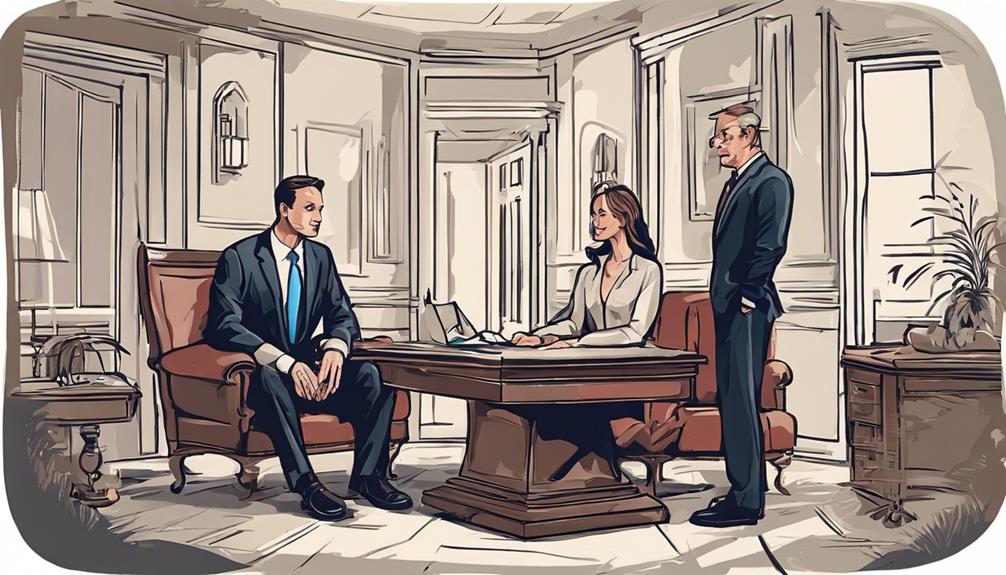When you divorce, your intellectual property—like patents, trademarks, and copyrights—becomes part of your marital assets and needs to be divided fairly. This involves valuing these rights accurately, which can be complex and often requires expert help. Sometimes, the rights are sold or negotiated, or one spouse keeps certain assets based on contribution. Understanding how these assets are handled can help you protect your interests—if you continue exploring, you’ll learn more about the process.
Key Takeaways
- Intellectual property is recognized as marital property and subject to division in divorce proceedings.
- Accurate valuation by professionals is essential for fair distribution of IP assets.
- Courts may order sale or negotiate buyouts of intellectual property rights between spouses.
- Ongoing income from licensing or royalties impacts the division and long-term financial benefits.
- Proper legal and expert involvement ensures fair handling and prevents loss of rights or income.

When going through a divorce, many people focus on dividing assets like property and savings, but intellectual property often gets overlooked. This oversight can cause complications later, especially if your business or creative works hold significant value. Understanding how intellectual property is handled during asset division is vital to protect your interests and guarantee a fair settlement.
Intellectual property, including patents, trademarks, copyrights, and trade secrets, can be a substantial part of your overall assets. When a couple divorces, the courts typically recognize these rights as property that can be divided, just like real estate or investments. However, valuing intellectual property isn’t always straightforward. You’ll need a professional business valuation to accurately determine its worth, especially if it’s integral to a business or ongoing enterprise. Without an accurate valuation, there’s a risk of either undervaluing or overestimating your assets, which can skew the asset division process.
Valuing intellectual property requires a professional assessment to ensure fair asset division during divorce.
During divorce proceedings, the court will take into account how the intellectual property contributes to your financial situation. If you own a patent that generates income or a trademark critical to your business, these assets may be deemed marital property. The goal is to divide assets fairly, which doesn’t always mean equally. Factors like each spouse’s contribution to the creation or growth of the intellectual property, how it’s used, and its current market value all play a role in the decision-making process.
If you and your spouse jointly own intellectual property, you might negotiate a buyout or co-ownership agreement. Sometimes, one spouse may retain rights to certain intellectual property if they contributed more substantially to its development or if it aligns with their career or business. Alternatively, courts may order the sale of intellectual property assets, with proceeds split between both parties. This process requires careful planning and often involves experts to determine the asset’s value and guarantee proper asset division.
In some cases, intellectual property can be a source of ongoing income, making it more complex to divide. You’ll want to consider the long-term implications of any division, including licensing agreements or royalties that may continue to generate revenue. Properly addressing these aspects guarantees that you don’t unintentionally lose future earnings or control over your intellectual property.
Additionally, understanding the valuation process involved in assessing intellectual property can help you better prepare for negotiations and court proceedings. Ultimately, handling intellectual property in divorce demands a clear understanding of its worth and how it fits into your broader assets. Engaging professionals like appraisers or legal experts can help navigate this complex area, ensuring your interests are protected during asset division.
Frequently Asked Questions
How Is Intellectual Property Valued During Divorce Proceedings?
During divorce proceedings, you have your intellectual property valued through asset valuation, which considers its worth as part of your overall estate. An expert may be brought in to assess the value based on current market conditions and potential income. Under intellectual property law, the court then determines how to divide this asset fairly, ensuring your rights are protected while recognizing the asset’s contribution to your financial situation.
Who Retains Rights to Jointly-Created Intellectual Property After Divorce?
You typically retain rights to jointly-created intellectual property if it’s a result of your partnership and both parties contributed equally. However, in partnership disputes or licensing agreements, the court may decide based on the contributions, intentions, and agreements made during the marriage. It’s essential to review any contracts or agreements you have, as they can influence how rights are divided post-divorce.
Can Intellectual Property Be Divided Equally Like Other Assets?
You can’t automatically divide intellectual property equally like other assets. Copyright disputes and patent rights often require negotiation or court intervention, especially if both spouses contributed considerably. The court considers factors like each person’s contribution, the timing of creation, and how the property is used. To protect your rights, you should consult a legal expert who can help navigate these complexities and guarantee fair resolution of your intellectual property in divorce.
What Legal Steps Are Needed to Transfer Ownership of IP?
Think of transferring IP like passing a baton in a relay race. To do this, you typically file for copyright registration or patent licensing, ensuring the legal ownership shifts smoothly. You’ll need to draft a formal agreement, sign it, and possibly record the transfer with the relevant patent or copyright office. These steps legally establish your new ownership, making sure your intellectual property stays protected and properly assigned during the divorce process.
How Does International Law Affect IP Division in Divorce Cases?
International law complicates IP division in divorce cases by affecting cross border enforcement and relying on international treaties. You might find that treaties like the Hague or the Patent Cooperation Treaty help enforce property rights across countries. However, the division depends on each country’s laws and treaties, so you should consult legal experts familiar with international law to navigate enforcement, jurisdiction, and the recognition of ownership or transfer of IP rights across borders effectively.
Conclusion
Think of your intellectual property as a treasured garden you’ve cultivated together. When divorce blooms, it’s like dividing the land—each of you takes what’s yours, ensuring your unique blooms stay alive. Just as a gardener tends to their plants, you’ll need clear boundaries and care to protect your creations. Remember, your ideas and inventions are your legacy—nurture them wisely, and they’ll continue to flourish long after the divorce is settled.









